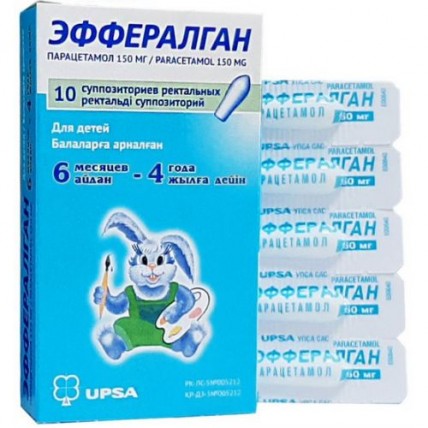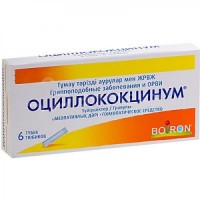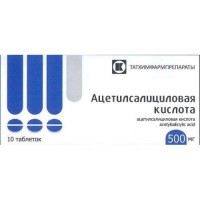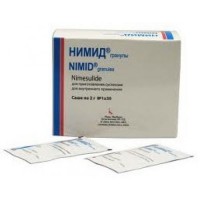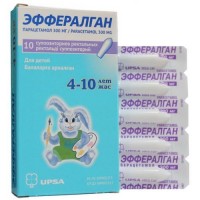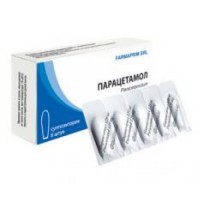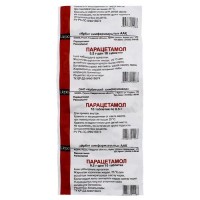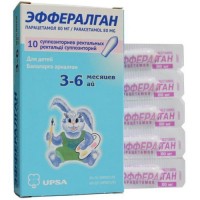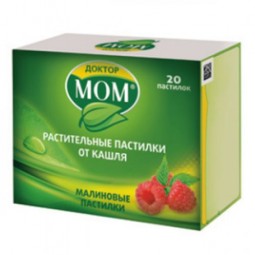Efferalgan 150 mg rectal suppositories 10s
- $9.70
The instruction for medical use of EFFERALGAN medicine the Trade name Efferalgan Mezhdunarodnoye the unlicensed name Paracetamol Dosage Form Suppositories rectal, 80 mg, 150 mg, 300 mg Structure One suppository contains active agent – paracetamol of 80 mg, 150 mg or 300 mg respectively, excipient – solid fat. The description Suppositories of white color with a smooth and brilliant surface. Pharmacotherapeutic group Analgetics and antipyretics. The ATX N02BE01 code the Pharmacological Pharmacokinetics Absorption properties of paracetamol at rectal administration happens more slowly, but is fuller, than at oral introduction. The maximum concentration in plasma are reached in 2-3 hours after reception. Paracetamol is quickly distributed in all fabrics. Concentration in blood, saliva and plasma are comparable. Linking with proteins of plasma weak. Paracetamol is mainly metabolized in a liver and removed with urine. 90% of the accepted dose are removed by kidneys within 24 hours, generally in the form of glyukuronidny conjugates (60-80%) and sulphatic conjugates (20-30%). Less than 5% are removed in not changed look. Elimination half-life – 4-5 hours. An insignificant part of paracetamol with the participation of P450 cytochrome turns into the metabolite entering connection with glutathione and is removed with urine. At overdose the quantity of this metabolite increases. In case of a heavy renal failure (the clearance of creatinine is lower than 10 ml/min.), removal of paracetamol and its metabolites slows down. Efferalgan's pharmacodynamics suppositories possess soothing and febrifugal action. The mechanism of action is connected with inhibition of synthesis of prostaglandins, primary influence on the center of thermal control in a hypothalamus. Indications - symptomatic treatment of pain from easy to moderate intensity and/or feverish states. The route of administration and doses use Drug rektalno only at children from 3 months to 10 years. The recommended daily dose of paracetamol depends on the body weight of the child at the rate of 60 mg/kg/day divided into 4 receptions. The single dose – to 15 mg/kg is each 6 hours, receptions have to be with equal intervals including at night. At children it is necessary to observe dosing according to the body weight of the child. The age and the body weight corresponding to it are given approximately. To children with the body weight from 4 to 10 kg (from about 3 to 6 months) enter on 1 candle (80 mg) of no more than 4 times a day every 6 hours, without exceeding 4 suppositories a day. To children with the body weight from 10 to 14 kg (approximately from 6 months to 4 years) enter on 1 candle (150 mg) of no more than 4 times a day every 6 hours, without exceeding 4 suppositories a day. To children with the body weight from 14 to 24 kg (approximately from 4 to 10 years) enter on 1 candle (300 mg) of no more than 4 times a day every 6 hours, without exceeding 4 suppositories a day. In case of diarrhea the purpose of a suppository is not recommended. It is not necessary to apply more than 4 suppositories a day. In case of a heavy renal failure (the clearance of creatinine is lower than 10 ml/min.) the interval between two receptions has to be at least 8 hours. Due to the risk of manifestations of local toxicity treatment duration has to be in the rectal way shorter. Side effects - an acute anaphylaxis, a Quincke's edema, an erythema, a small tortoiseshell and skin rash, rectal and anal irritations. Seldom - a thrombopenia, a leukopenia and a neutropenia. At emergence of side reactions it is necessary to stop intake of this medicine and related drugs at once. Contraindications - hypersensitivity to paracetamol - hepatocellular insufficiency - recently postponed proctitis, an anusitis or rectal bleeding in the anamnesis - children's age up to 3 months. Medicinal interactions Oral anticoagulants Paracetamol strengthens effect of oral anticoagulants and increases risk of developing of bleeding in case of reception in the maximum doses (4 g/day) within not less than 4 days therefore regular control of the prothrombin ratio is necessary. If necessary it is necessary to adjust the mode of dosing of anticoagulants during use of paracetamol and after its cancellation. Influence on results of laboratory tests Intake of paracetamol can distort results of laboratory analyses when determining content of glucose in blood by the method based on reaction of glucose oxydas-peroxidase in case of abnormally increased concentration. Intake of paracetamol can distort results of laboratory analyses when determining concentration of urea in blood by method with use of phosphatotungstic acid. Special instructions in order to avoid risk of overdose it is necessary to check lack of paracetamol as a part of other medicines. The maximum recommended doses: - at children with body weight to 37 kg the maximum daily dose of paracetamol should not exceed 80 mg/kg/day, - at children with the body weight from 38 to 50 kg the maximum daily dose of paracetamol should not exceed 3 g/day, - at adults and children with body weight more than 50 kg the maximum daily dose of paracetamol should not exceed 4 g/day. For the children receiving 60 mg/kg/day of paracetamol, the combination with other febrifuge is justified only in case of inefficiency. In case of diarrhea the purpose of suppositories is not recommended. When using suppositories there is a risk of local toxicity, especially at frequent and prolonged use. Pregnancy and the period of a lactation Drug is intended for use only for children from 3 months to 10-year age. Paracetamol gets through a placental barrier and is emitted with breast milk. In case of use of paracetamol at pregnancy and in the period of a lactation it is necessary to weigh carefully expected advantage of therapy for mother and potential risk for a fruit and the child. The feature of influence of drug on ability to run motor transport and dangerous mechanisms does not influence. The overdose Exists risk of poisoning at elderly people and extra risk at small children (therapeutic overdose or often accidental poisoning) which can be life-threatening. Symptoms: the nausea, vomiting, anorexia, pallor, an abdominal pain which are usually developing in the first day. Single dose more than 10 g of paracetamol by the adult and single dose by the child in a dose more than 150 mg/kg of body weight can cause the necrosis of hepatocytes resulting in hepatocellular insufficiency, a metabolic acidosis, encephalopathy and a lethal outcome. In 12-48 hours after overdose the increase in level of hepatic transaminases, a lactate dehydrogenase and bilirubin and also decrease in level of a prothrombin can be noted. Treatment: at manifestation of symptoms of poisoning immediately see a doctor. Blood test on determination of level of paracetamol in plasma, gastric lavage (in case of intake), intake of antidote of N-Acetylcysteinum intravenously or orally within 10 hours after intake of medicine, symptomatic treatment is recommended. A form of release and packing On 5 suppositories in blister strip packaging. On 2 blister strip packagings together with the instruction for medical use in the Kazakh and Russian languages place in a cardboard box. To Store storage conditions at a temperature not above 30 °C. To store out of children's reach! 3 years not to use a period of storage after an expiration date. Prescription status Without prescription UPSA SAS Producer, 304 Avenue du Doctor Jean Bru, 47000 Azhen, France. Owner of the registration certificate of UPSA SAS, 3 Rue Joseph Monie, 92500 Ryuey-Malmezon, France. The name and the address of the organization in the territory of the Republic of Kazakhstan, the accepting claim (offer) on quality of medicine from consumers, responsible for post-registration observation of safety of medicine Representative office of JSC Delta Medikel Promoushnz AG (Switzerland), 050040, Almaty, Bostandyksky district, Bayzakov St., 280
